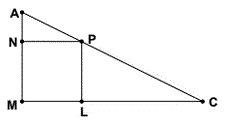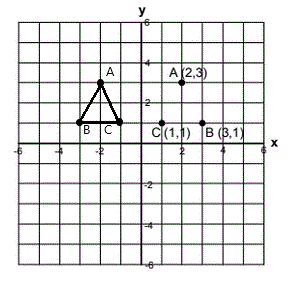| Problem |
Solution |
|
1) Toleen's math teacher makes a model of a solid rectangular prism out of white one centimeter
cubes to explore surface area and volume. She paints the entire outside surface red. If the
dimensions of the prism are 3 cm by 4 cm by 6 cm, how many of the cubes have exactly two sides
painted red?
|
1. The cubes which have 2 sides painted are the edges that are not on the corners.
2. There are 4 3 cm edges, 4 4 cm edges and 4 6 cm edges.
3. Subtract 2 for each edge (for the corners) and then multiply by the above numbers to get the total number of edge cubes that are not corners =
(3 - 2) x 4 + (4 - 2) x 4 + (6 - 2) x 4 =
28 cubes that have 2 sides painted.
|
 2) In right triangle AMC (see diagram) triangles ANP and
PLC are similar. MNPL is a square. Segment MC has
length 6 units and segment LC has length 4 units. What is
the area of triangle ANP?
2) In right triangle AMC (see diagram) triangles ANP and
PLC are similar. MNPL is a square. Segment MC has
length 6 units and segment LC has length 4 units. What is
the area of triangle ANP?
|
1. Write the lengths of MC and LC on the diagram.
2. Compute the length of a side of the square (ML and NP) = 2 units and write those lengths on the diagram.
3. Since the triangles are similar, the scale factor of the triangles is NP/LC = 2/4 = 1/2
4. Apply this scale factor to NP to get the length of AN =
(1/2) x 2 = 1 unit
5. Compute the area of ANP using the lengths of NP and AN =
(1 x 2)/2 = 1 sq. unit
|
 3) The points of an isosceles triangle are A=(2,3),
B=(3,1), and C=(1,1). If you rotate the triangle 180
degrees about the origin and then reflect the triangle
across the x-axis, what are the new coordinates for
A, B, and C?
3) The points of an isosceles triangle are A=(2,3),
B=(3,1), and C=(1,1). If you rotate the triangle 180
degrees about the origin and then reflect the triangle
across the x-axis, what are the new coordinates for
A, B, and C?
|
1. If you rotate the triangle 180 degrees around the origin that puts it in quadrant III upside-down. Perform that and draw in the new points in that quadrant.
2. If you reflect the triangle across the x-axis that puts it into quadrant II, right-side up again. Draw in those points.
3. The new coordinates are
A: (-2,3)
B: (-3,1)
C: (-1,1).
See figure to the left. Notice that the positions of B and C have reversed!
|